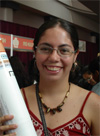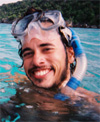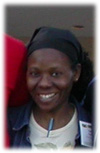2004-2005 Fellows
Cohorts Funded by the Andrew W. Mellon Foundation
 Bruce Machona
Bruce Machona
Wiley College
Mentor: Gary Lovett
Since the tender age of my life I enjoyed going out and watching the water flowing in the river and mountain hiking and studying most of the living organisms around me in Zimbabwe. I should say I became interested in Ecology when I was a child. My mother was an ecologist not by training but naturally, and she was the most influential person in igniting my interest in ecology. Unfortunately, when I went to high school, I did not take an Ecology or science course. The school system selected courses for you. So when I went to college for the first time I did my studies in Accounting. But this was not my passion, fortunately enough when I came to America I had to take many classes in Biology, which played a major role in shaping my future. The challenges that I faced included the jargon and terminology used in the sciences because I did not have a strong background in science. However, if you have the passion for something, learning will be easy. I had the determination to learn, and with good professors, I succeeded. Field trips sponsored by ESA/SEEDS helped me a lot in motivating me and it helped me improve my understanding of what is Ecology.
Thanks to ESA.
Project Title:”Effect of nitrogen addition on fine roots in an oak forest”
 Julie James
Julie James
Haskell Indian Nations University
Mentor: Alan Knapp
Mentor Institution: Colorado State Univerisity
I entered college as a non-traditional student at Haskell Indian Nations University in Lawrence, Kansas. I began college in Computer Information Systems. At the time, it seemed that computers were the way to go, but I quickly found I had no love for this program. I switched majors and was accepted into the Environmental Science program. This is when I knew I was going to do something I would enjoy. The instructors at Haskell have all been very supportive and influential in keeping my interests focused. Another influence has been SEEDS. I attended my first SEEDS field trip to Baltimore in November of 2003. Immediately I felt at home with the other field trip participants. The students all had some of the same ideas and interests as me. This was also my first exposure to professionals in ecology other than my professors.Through my initial involvement with SEEDS and the Haskell Ecology Club I learned of the SEEDS fellowship. I applied, was accepted, and subsequently was able to attend the August 2004 ESA conference in Portland. At the conference I was able to experience first hand what the fellowship entailed by attending the presentations of the current fellowship recipients and visiting with them.The SEEDS program coordinated a mentor match for me and has helped me stay on task throughout the year. My mentor, Alan Knapp, is extremely knowledgeable. His knowledge and enthusiasm has helped me through the tough parts of my project. My research project is studying native grasses on the Konza Prairie in Manhattan, Kansas. I am observing the growth in different water treatments and how these treatments affect the production of vegetative versus reproductive growth.
Project Title:”Phenology and allocation to flowering in C3 and C4 grasses in a mesic grassland: implications for climate change.”
 Lucero Vasquez-Radonic
Lucero Vasquez-Radonic
University of Texas at El Paso
Mentor: Rebecca Ostertag
Mentor Institution: University Of Hawaii At Hilo
I remember going to the beach with my mother, and collecting every seashell I could find. I would fill boxes full of seashells, always thinking that they were beautiful decorations of the sand, but never realizing that the ocean was full of life and value. My mother always inculcated it in me to respect nature and see it as a gift and a responsibility to humankind, not as a commodity or property. Now I realize I did not fully understand my mother’s perception of nature until I went on a trip to the Tambopata National Reserve, in the Peruvian Amazon Rain Forest as a high school student. At Tambopata I understood the importance of ecology to further knowledge, and more importantly, to conserve the earth’s natural resources and the existing human cultures. At UTEP, my advisor was great at letting us know about every opportunity available, and she was the one who let me know about the SEEDS field trip to the Kananaskis field station, and consequently, I came to find out about the SEEDS fellowship. For my SEEDS fellowship research, I am working with Dr. Rebecca Ostertag of the University of Hawaii at Hilo, studying the seed rain and the soil seed bank at the Hawaiian lowland wet forest to contribute to the understanding of the mechanisms by
which introduced species are out competing native species. This understanding is necessary so that these forests can remain as functioning systems where the native species survive competition by invasive introduced species. This information may help us understand their competitive success, proving us the tools to develop alternative control methods that could be applied at the different life stages of the plant.
Project title: “Understanding the interrelations of native and introduced species in the Hawaiian lowland wet forest through seed rain and soil seed bank quantification.”
 Ricardo Colon
Ricardo Colon
University of Puerto Rico at Humacao
Mentor: Alberto Sabat
I’ve been interested in ecology since I was a little kid. I grew up surrounded by a strange mix of nature and urban development in the island of Puerto Rico. I was always marveled by the ocean and by science. My main influence comes from Marine biologists and ecologists from the University of Puerto Rico in Humacao and in Río Piedras. I had the wonderful opportunity to attend to the SEEDS Urban Ecology Field Trip that was held in Baltimore, Maryland. That was the first time I heard about the SEEDS fellowship. My fellowship mentor, Dr. Alberto Sabat, and I came up with a project to compare urchin densities in different types of coral reefs that we expect to differ in predator presence, resource abundance, and water quality. We want to know how this keystone specie is distributed along these types of environments to establish a relation, if any, between these factors and the presence of (Diadema antillarum) on the coral reefs of Puerto Rico. Ecology has an important role in the future of science. Everyone talks about biotechnology and genetic engineering, but we can’t forget the role of ecology in our world. We humans are an integral part of the environment, our actions greatly affect the ecosystem, and mother nature can have quite a vengeance if she wants. I think ecological research is a vital part in the process of saving our planet.
Project Title:”The effects of predator abundance and food availability on the abundance of the sea urchin Diadema Diadema antillarum in Puerto Rico.”
 Thalia Tooke
Thalia Tooke
University of Kansas
Mentor:Tracy Benning
Mentor Institution: University of San Francisco
Deciding to study ecology or environmental science came about after studying biology and chemistry, because I saw how the basics of natural sciences are used in ecology and environmental science. All the sciences are interconnected and the problems facing the world today can be best addressed with a combination of science, social science, and humanities approaches. I have overcome many challenges that consisted of learning disabilities, family illness, personal illness, not enough resources to pay for school and the basics to live, etc. I have persevered because I believed in myself and my dreams and goals.I learned about the SEEDS fellowship program by searching the internet. My fellowship project is about weed management strategies in landrace maize fields in the highlands of Chiapas, Mexico. I spent the summer interviewing 60 subsistence farmers on how they manage their weeds. The only advice I can give is to find out what it is you don’t like to do. That is the starting point to find out what it is you like to do or are interested in. What is it that you love to do (that you have a passion for)? What would you do even if you did not get paid for it?
Project title: “Weeding strategies and the potential for adoption of glysophate-based technology in traditional maize production systems in Central Chiapas.”